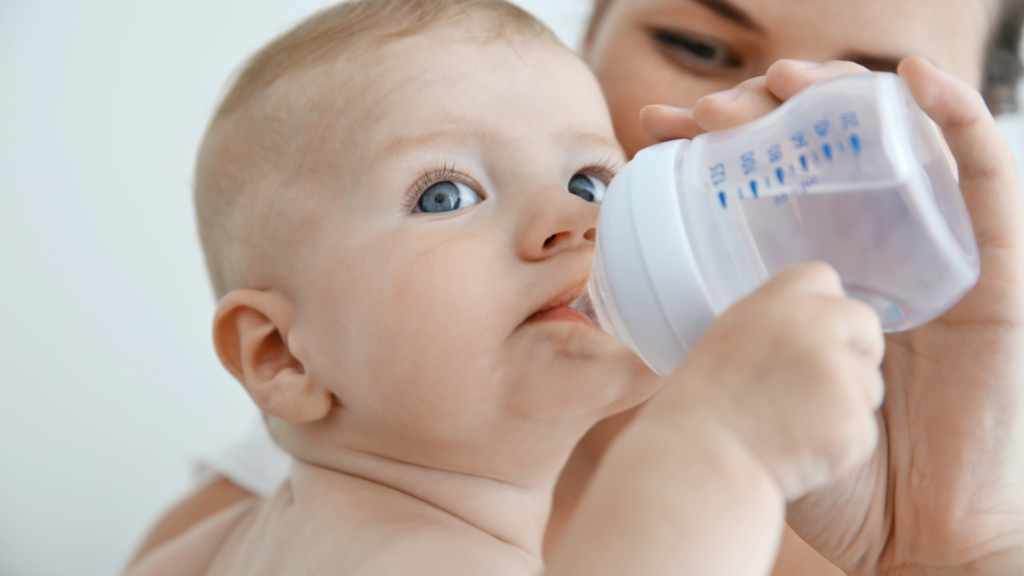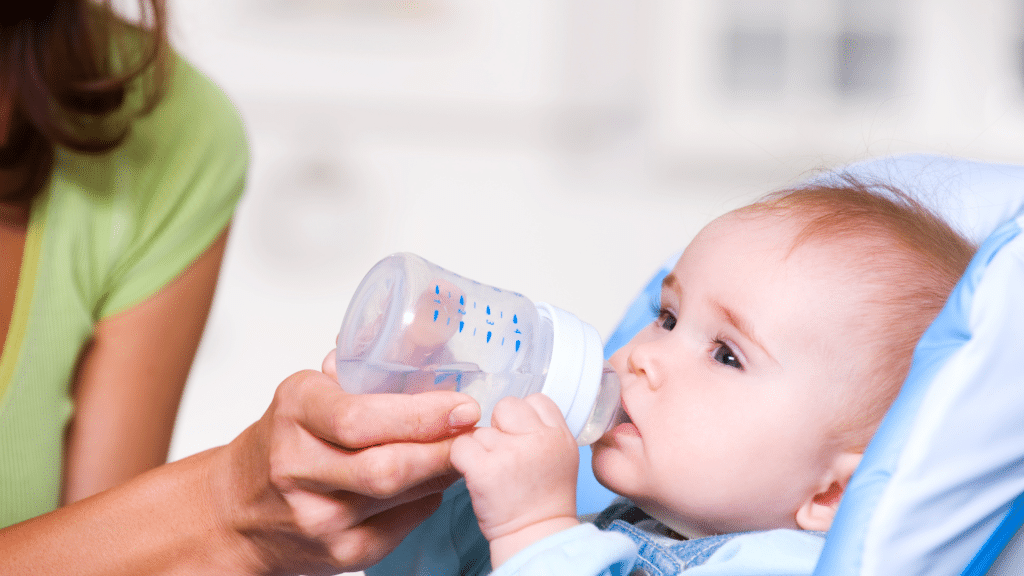Hydration plays a vital role in everyone’s life, especially for infants whose body systems are in the early phases of development. Babies’ unique hydration needs demand a precise understanding of how their hydration requirements vary from adults and older children.
This article will guide you through the fundamentals of baby hydration, ranging from understanding the importance of breast milk/formula to the safe and gradual introduction of water. You will also learn how to create ideal hydration habits, transition from bottle to sippy cup, understand the role of hydration when introducing solid foods, the significance of clean water and containers, and learn to recognize the signs of dehydration.

Understanding Baby Hydration Needs
Infants have unique hydration needs compared to adult and older children due to their smaller body size, faster metabolic rate, and dependency on adults for energy and fluid intake. Their immature kidneys also make it hard for them to naturally balance water and electrolytes, making correct hydration an important part.
Crying without tears, fewer wet diapers, dark yellow urine, dry mouth, and unusual sleepiness or irritability are some signs of dehydration in infants. Understanding the hydration needs of your baby is a good start to prevent these symptoms.
Relation of Breast Milk/Formula and Baby Hydration
Breast milk and infant formula provide not only essential nutrients for growth and development but are also the primary sources of hydration for infants. Both comprise high water content that serves to meet a baby’s hydration needs.
Breast Milk
Breast milk adjusts to the hydration needs of the baby and provides exceptional hydration. On hot days or in case the child is sick and prone to dehydration, the mother’s body increases the water content of the milk, thus highlighting the importance of the parenting role in infant hydration.
Infant Formula
Like breast milk, infant formula also contains a significant amount of water. If prepared correctly according to package instructions, it should provide ample hydration. However, it’s essential not to dilute the formula excessively to increase fluid intake, as this can lead to nutrient deficiency.
It’s important to consult a healthcare provider for personalized advice, taking into account the baby’s age, birth weight, and general health status. They are the best source of guidance for understanding baby hydration needs and making feeding decisions. Such discussions should be an integral part of the family discussions and decisions, emphasizing the involvement of families in every step of the infant’s growth and development.
Remember, it’s essential for infants to maintain their regular sleep and feeding schedule. It helps ensure that they get proper hydration and stay healthy.

Gradual Introduction of Water
Introducing water into an infant’s diet should be done gradually and in accordance with age-appropriate milestones. Below is a step-by-step guide:
- First 6 Months: It’s generally recommended that babies under six months of age do not need additional water. Breast milk or formula should be the sole source of hydration and nutrition.
- 6-12 Months: As you introduce solid foods (usually around six months of age), you can also begin to introduce small amounts of water. To start, only a few sips from a cup or a spoonful or two of water is enough.
- After 1 Year: After their first birthday, water can constitute a more significant portion of their fluids. However, breast milk, formula, or whole cow’s milk (if introduced by a healthcare provider) should still play a major role in their diet to ensure they are receiving enough nutrients.
Age-Appropriate Milestones for Water Introduction
- Six months: This is usually the age when infants can first begin to drink sips of water along with solid foods. React accordingly to your child’s acceptance level.
- 9-12 months: Around this age, the infant might be starting to use a sippy cup. Offer water in a sippy cup at meals.
- One year and older: After age one, an infant can begin drinking more substantial amounts of water, usually around 8 ounces (1 cup) a day.
Creating Hydration Habits
Creating and maintaining healthy drinking habits in infancy can set the groundwork for lifelong positive habits. Here are some tips:
- Consume liquids at meal times: Introduce water during meals when you begin offering solid foods. This helps develop a pattern of fluid intake along with meals.
- Gradual introduction of a sippy cup: From around six months old, offer water in a sippy cup so that your baby becomes familiar with it.
- Model healthy hydration: Kids are great imitators. Show them how you drink water regularly to subtly encourage them to do the same.
- Offer water as the first choice: Encourage the idea that water is the first go-to for thirst to set a healthy lifelong habit.

Transitioning from Bottle to Sippy Cup
Transitioning your baby from a bottle to a sippy cup is an important milestone for developing good drinking habits. Here’s a quick guide to the process:
- Introduce the sippy cup: Begin by introducing the sippy cup to your baby at meal times when they are around six months old.
- Alternate between bottle and cup: For a couple of weeks, alternate between giving their drink in a sippy cup and a bottle. This helps them get used to the new drinking vessel.
- Reduce usage of bottles: Slowly decrease the number of bottles given each day. Replace one bottle of feed each week with a sippy cup.
- Stop the bottle completely: Once your baby is comfortable with the sippy cup, discontinue using the bottle. This transition should ideally be complete by the time the child is about one year old.
Hydration and Solid Foods
Introducing solid foods to your baby’s diet signifies a significant stage in your child’s growth. However, it’s not just about the food; it’s equally about hydration. Balancing the baby’s water intake becomes crucial during this transitional stage.
As you explore the world of solid foods with your little one, understanding the integral role of hydration is key. Water aids digestion and helps smoothly break down solid foods, making them easier for your baby’s developing digestive system to process. Hence, the entry of solid foods into your baby’s diet should be escorted by proportionate amounts of water.
However, gauging the right quantity can sometimes be challenging. Keeping an eye out for signs of appropriate hydration, like regular wet diapers, can guide you. Overhydration and dehydration both have their own set of symptoms, being aware of which can help prevent those scenarios.
Babies, unlike adults, have distinct nutritional needs. The phase when babies transition from exclusive breastfeeding or formula-feeding to the inclusion of solid foods is termed complementary feeding. As the world of taste and texture expands for your baby, it’s pivotal to strike a balance with water intake, as overconsumption can impact nutrient absorption negatively, resulting in nutritional deficiencies.
Planning a diet that aligns milk, water, and solids efficiently plays a critical role at this stage. Overcoming the obstacles that come with maintaining this balance might look intimidating for families, but with careful parenting, monitoring, and perhaps a pediatric consultation, it becomes pretty achievable. Remember, your strides in this journey mold your baby’s dietary patterns and health in the future!
Safety First: Clean Water and Containers
Water, while being a fundamental need, also stands as a crucial factor in ensuring your baby’s health during the initial stages of growth. It’s not just about the right amount but also about the cleanliness and safety of the water and its storage containers.
Since babies have delicate immune systems, even the minutest contamination can quickly propagate to health issues. This makes maintaining the purity of the source of water for your baby and the cleanliness of the containers used to store and dispense it extremely imperative. A simple regimen of sterilizing the feeding equipment before every use can go a long way in safeguarding your little one’s health.
Additionally, parent should always opt for water that’s safe for your baby bottled water labeled as de-ionized, demineralized, purified, or distilled can be a safe choice.

Tips for Using Safe and Appropriate Water Storage Options
Beyond cleanliness and sterilization of containers, the materials used in the containers and storage techniques also hold significance. Opt for BPA-free plastic, glass, or stainless steel containers for water storage to prevent any harmful chemical leaching.
An overlooked yet crucial aspect is the temperature of storage—always store drinking water in a cool, dry place away from direct sunlight to maintain the high-quality standards of the water you serve your little one. Parenting involves implementing these safety tips to ensure that your baby stays well-hydrated while navigating the journey of growth healthily!
Recognizing Dehydration
While ensuring your little one’s adequate hydration levels, it is essential for parents to understand how to identify the symptoms of dehydration. Being aware of these signs and knowing how to respond enables prompt action, ultimately preventing any complications. Recognizing dehydration is not only vital for infants, but it also serves as a useful skill when identifying possible cases in older children, adults, and even oneself.
In this section, we will provide you with detailed information on the various signs of dehydration, focusing on the symptoms in infants, older children, and adults. We’ll also explore the unique factors that make babies and young children more susceptible to dehydration.
By the end of this section, our goal is for you to feel confident and well-informed about recognizing dehydration, understanding its effects, and taking appropriate measures to ensure your baby, other family members, and yourself stay well-hydrated and maintain overall health.
Signs of Dehydration in Babies
Babies, owing to their developing physiology, can get dehydrated more quickly than adults. Thus, recognizing the vital warning signs, such as fewer wet diapers, dry lips, and mouth, sunken eyes or cheeks, lethargy, or irritability, becomes crucial for them. Adults should be aware of signs such as excessive thirst, dark or low urine output, dizziness, fatigue, or dry skin.
Moreover, if you witness your baby crying without tears, having a high fever, or your adult friends experiencing confusion or rapid heartbeat, they might be dealing with severe dehydration, which calls for an immediate response.
Actionable Steps to Take if You Suspect Your Baby Is Dehydrated
If you notice any of the dehydration symptoms in your baby or during a date, it’s essential to respond promptly. Initially, offer small but frequent sips of water alongside regular nursing or bottle-feeding sessions for babies. If your date seems thirsty or shows signs like dry lips and exhaustion, suggest sipping water frequently.
Also, for babies, try using oral rehydration solutions if approved by your doctor. For your date, suggest drinks that are rich in electrolytes, like coconut water. However, if the symptoms seem to persist or worsen in either your baby or your date, don’t hesitate to seek immediate medical attention.
Ensuring your baby and your date are properly hydrated is not only crucial for digestion while introducing solid foods to your baby, but also fundamental to their, and your date’s, overall well-being and growth.

Conclusion
In conclusion, nurturing your baby’s hydration is a vital aspect of their growth and development. Understanding the unique hydration needs of infants and recognizing essential milestones can help build a strong foundation for healthy habits. Breast milk and formula serve as the primary sources of hydration in a baby’s early months, while the gradual introduction of water and solid foods plays a crucial role later on.
Parents must focus on creating healthy hydration routines, maintaining the cleanliness and safety of water sources and containers, and identifying signs of dehydration in their young ones. Debunking myths about juice as a hydration alternative and making evidence-based decisions ensures that parents can confidently fulfill their child’s hydration needs.
By following these guidelines and seeking advice from a healthcare provider, your baby’s journey towards healthy hydration will be well-supported, contributing to their overall well-being. And always remember, baby water is an essential element of your little one’s growth that should be balanced and monitored carefully.
Did this article help you? Please let us know by commenting below. If you have any questions, don’t hesitate to ask.



